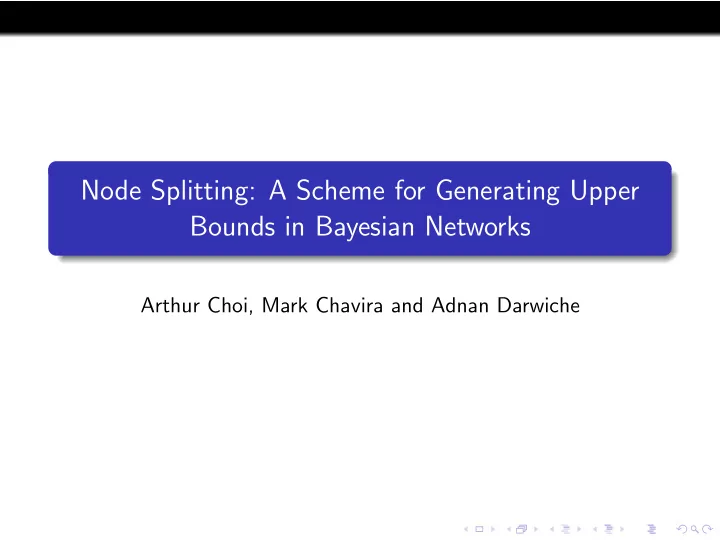

Node Splitting: A Scheme for Generating Upper Bounds in Bayesian Networks Arthur Choi, Mark Chavira and Adnan Darwiche
Purpose To formulate a mini-bucket algorithm for approximate inference in terms of exact inference on an approximate model produced by splitting nodes in a Bayesian network.
Purpose To formulate a mini-bucket algorithm for approximate inference in terms of exact inference on an approximate model produced by splitting nodes in a Bayesian network. Reduced search space
Purpose To formulate a mini-bucket algorithm for approximate inference in terms of exact inference on an approximate model produced by splitting nodes in a Bayesian network. Reduced search space New mini-bucket heuristics
Purpose To formulate a mini-bucket algorithm for approximate inference in terms of exact inference on an approximate model produced by splitting nodes in a Bayesian network. Reduced search space New mini-bucket heuristics Mini-bucket benefit from recent advances in exact inference
Introducing a problem Most probable explanation - MPE Definition Given a Bayesian network N with variables x , inducing distribution Pr . Then the MPE for some evidence e is: MPE ( N , e ) = argmaxPr ( x ), where x and e are compatible. Note solution may not be unique. The MPE probability is: MPE p ( N , e ) = maxPr ( x ).
Example: Splitting nodes Split according to children Split along an edge Fully split Key property of split networks MPE p ( N , e ) ≤ β MPE p ( N ′ , e ,� e )
Example: Splitting nodes Split according to children Split along an edge Fully split Key property of split networks MPE p ( N , e ) ≤ β MPE p ( N ′ , e ,� e )
Mini-bucket elimination What is mini-bucket elimination? Mini-bucket elimination is a simple variation of the variable elimination algorithm.
Mini-bucket elimination Bayesian network N Variable elimination 1 Mini-bucket elimination 2
Example: Variable elimination Algorithm 1 VE ( N , e ) Variable elimination on N
Example: Variable elimination Algorithm 1 VE ( N , e ) Variable elimination on N To eliminate variable X Select all factors that 1 contain X (line 6) Multiply all factors 2 that contain X and max-out X from the result (line 7)
Example: Variable elimination Algorithm 1 VE ( N , e ) Variable elimination on N To eliminate variable X Select all factors that 1 contain X (line 6) Multiply all factors 2 that contain X and max-out X from the result (line 7) Returns MPE p ( N , e )
Example: Variable elimination Algorithm 1 VE ( N , e ) Variable elimination on N To eliminate variable X Select all factors that 1 contain X (line 6) Multiply all factors 2 that contain X and max-out X from the result (line 7) Returns MPE p ( N , e ) Bottleneck on computational resources when multiplying
Example: Mini-bucket elimination Algorithm 2 MBE ( N , e ) Mini-bucket elimination on N
Example: Mini-bucket elimination Algorithm 2 MBE ( N , e ) Mini-bucket elimination on N To eliminate variable X Select some factors 1 that contain X (line 6) Multiply the selected 2 factors that contain X and max-out X from the result (line 7) Repeat till X have been 3 completely removed
Example: Mini-bucket elimination Algorithm 2 MBE ( N , e ) Mini-bucket elimination on N To eliminate variable X Select some factors 1 that contain X (line 6) Multiply the selected 2 factors that contain X and max-out X from the result (line 7) Repeat till X have been 3 completely removed Returns an upper bound on MPE p ( N , e )
Correspondence Node splitting approach Algorithm 3 SPLIT − MBE ( N , e ) Given a network N and evidence e , algorithm 3 returns a split network N ′ and a variable ordering π ′ , that corresponds to a run of mini-bucket elimination on N and e .
Example: Correspondence
New mini-bucket heuristics Given the correspondences, every mini-bucket heuristic can be interpreted as a node splitting strategy. Old mini-bucket heuristics 1 New mini-bucket heuristics 2
Old mini-bucket heuristics Given a bound on the size of the largest factor: 1 Choose variable order 2 Pick set that is within the given bound of X 3 Repeat 2 till variable X is eliminated 4 Continue with next variable Seeks to minimize the number of clones introduced into the approximation N’
New mini-bucket heuristics Given a bound on the largest jointree cluster 1 Build a jointree of the network 2 Pick variable X who’s removal will introduce the largest reduction in the sizes of the cluster and seperator tables 3 Fully split variable X 4 Repeat till the bound is met Seeks to minimize the number of split variables
Reduced search space Proposition 1 MPE p ( N , z ) ≤ β MPE p ( N ′ , z ,� z ) Z contains all variables that were split in N to produce N ′ Once all variables in Z have been instantiated, the approximation is exact Once the bound on MPE p becomes exact, no better solution is reachable in N ′ Thus The search space size is exponential in the number of split variables, down from being exponential in the number of network variables
Additional result Mini-buckets benefit from recent advances in exact inference The evaluation of the mini-bucket approximation need not rely on any specific exact inference algorithm Node splitting approach in combination with a state-of-the-art arithmetic circuit outperform variable elimination
Recommend
More recommend